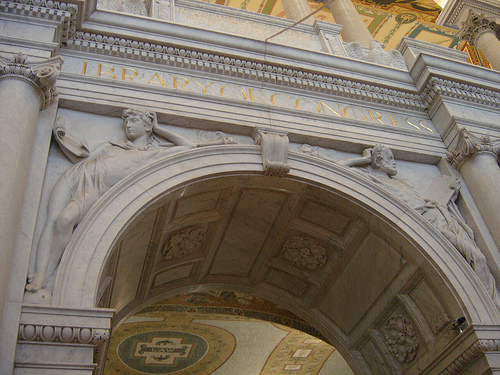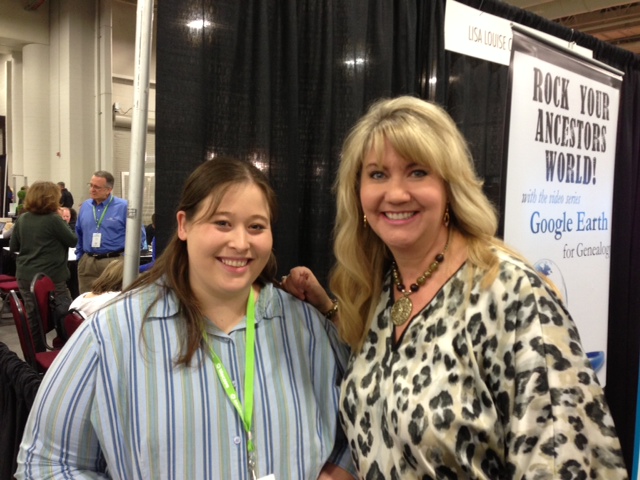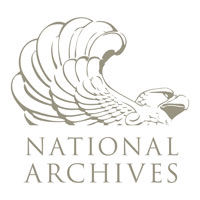by Lisa Cooke | Sep 28, 2013 | 01 What's New, Book Club, Inspiration, Research Skills
The Library of Congress has a new quick video tutorial to help us find things in their enormous collections, both offline and online.

Flickr Creative Commons image by Paull Young.
“How to Find Stuff at the Largest Library in the World” is a 5-minute introductory video. It shows how to use subject headings, research databases and other helpful tools to find books, photos, sheet music, manuscripts and more at the Library of Congress or other locations.
This video makes the Library of Congress seem much less intimidating. And we get some tempting glimpses of the inside of the Library. The tips they mention are helpful for navigating any research library though, so check it out!
by Lisa Cooke | Apr 5, 2013 | 01 What's New, Canadian, FamilySearch, Research Skills
“One of the most incredible and likely true stories I’ve ever seen!” announced Dave Obee as he met with Genealogy Gems Listener Sarah Stout, the winner of our #RootsTech 2013 conference registration contest.
The question to contestant was “who’s class would you most like to attend at RootsTech?” Sarah’s answer was Dave Obee, and that was because she was  running up against a Canadian brick wall in her family history research, and Dave is a Canadian Research Guru!
running up against a Canadian brick wall in her family history research, and Dave is a Canadian Research Guru!
Read more about Sarah’s incredible genealogical brick wall:
WATCH THE VIDEO
In my new video at the Genealogy Gems YouTube channel I get the two together and Dave dishes up 10 terrific tips that will not only help Sarah, but are sure to prove their worth in your own family tree climbing.
Dave Obee’s Top 10 Tips:
1. Create a Timeline – “plot her life…it’s easier to see the holes.”
2. Understand Geography – “plot movements”
3. Find Every Possible Record
4. Understand How Records Were Created
5. Read Every Local Story in Newspapers at that Time
6. Tap into Local Knowledge – “Locals know more” (historical and genealogical societies)
7. Go There if You Can in Person
8. Look for Negative Proof
9. Collaborate with Other Researchers
10. Be Diligent About Proof
Resources Mentioned in the video:
Subscribe to the Genealogy Gems YouTube Channel for free to receive instant updates of all of my latest videos from RootsTech 2013 and beyond.
by Lisa Cooke | Aug 7, 2012 | 01 What's New, Records & databases, Research Skills
Is the National Archives a research frontier you haven’t conquered yet? Well, that frontier just got a lot easier to tame. The Archives has released its own series of expert how-to videos on its most in-demand topics on its YouTube Channel at http://tinyurl.com/NARAGenie.
most in-demand topics on its YouTube Channel at http://tinyurl.com/NARAGenie.
The Know Your Records series introduces you to the creation, content, and use of valuable records created by the federal government. You’ll be able to make new inroads into your own American ancestral frontier along the trails of military, Freedmen’s Bureau, and other records groups when you check out new workshops like these:
- Access to Archival Databases for Genealogists (runs 55 minutes). This is an introductory level-discussion of the more popular parts of the 27 genealogically-interesting series of electronic records in the Archival Databases run by the National Archives. Learn the mechanics of searching these data files directly online.
- Army Service in the Civil War (runs 1 hour and 2 minutes). Learn to research Army service records of Civil War soldiers on both sides of the war. This video covers two major record groups: RG 94, the records of the Adjutant General (or chief record-keeper) for the Union Army; and RG 109, comprised of the Confederate records that survived the war and were turned over to War Department.”
- Documenting Death in the Civil War (runs 1 hour and 22 minutes). Learn how the War Department documented both Confederate and Union soldiers’ deaths on the battlefield, in military hospitals and prisons.
- Exodus to Kansas: The 1880 Senate Investigation of the Beginnings of the African American Migration from the South (runs 1 hour and 5 minutes). Learn more about the journey and experience of thousands of refugees from the Reconstruction-era South to Kansas as shown in the 1880 Senate investigation of this mass migration.
- Let No Man Put Asunder: Freedmen’s Bureau Marriage Records (runs 1 hour and 12 minutes). Learn more about marriage in the African American experience and specifically how to research African American marriage records within the Freedmen’s Bureau collection (1865-1872), the “richest and most extensive documentary source for investigating the African American experience in the post-Civil War and Reconstruction eras.”
- National Archives Records on Ancestry.com (runs 56 minutes). Learn from Ancestry’s own lead family historian, Anastasia Harmon, what National Archives records are available on Ancestry and strategies for searching for your ancestors on this mega site. She digs into much-used (but not always well-used) record groups like the U.S. federal census records, passenger arrival lists, border crossings and passport applications.
Of course, many of us don’t have known Civil War or African American ancestors. But everyone can learn from the first and last lectures on the list above (even if you only use Ancestry.com at your local library). So start exploring these free workshops, and soon you’ll be navigating the frontiers of your own American ancestry.


 running up against a Canadian brick wall in her family history research, and Dave is a Canadian Research Guru!
running up against a Canadian brick wall in her family history research, and Dave is a Canadian Research Guru!



